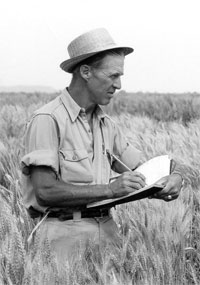 CIMMYT joins with members of the international development community to mourn the passing of Nobel Peace Laureate and renowned wheat scientist, Dr. Norman E. Borlaug, who died Saturday night at the age of 95 from complications from cancer, after an exemplary life dedicated to fighting hunger in developing countries.
CIMMYT joins with members of the international development community to mourn the passing of Nobel Peace Laureate and renowned wheat scientist, Dr. Norman E. Borlaug, who died Saturday night at the age of 95 from complications from cancer, after an exemplary life dedicated to fighting hunger in developing countries.
Dr. Borlaug worked as a CIMMYT wheat breeder and research director for nearly four decades and was a CIMMYT scientist at the time he received the Nobel Peace Prize.
High-yielding wheat varieties and improved farming practices, first developed by Borlaug and his team in Mexico during the 1950s, were introduced into South Asia in the 1960s and may well be responsible for saving hundreds of millions of people from starvation. Known as the Green Revolution, Borlaug’s work gave rise to science-based agriculture in developing countries. Today, high-yielding, disease-resistant wheat varieties based on Dr. Borlaug’s pioneering work are grown on 80 million hectares (200 million acres) throughout the world.
Borlaug received the 1970 Nobel Prize for those achievements, and his success led to the establishment of a network of 15 international agricultural research centers, including CIMMYT.
Borlaug’s full-time employment at CIMMYT ended in 1979, although he remained a resident part-time consultant until his death. In 1984, he began a new career as a university professor, teaching one semester a year at Texas A&M University, which continued for 23 years. In 1986, he joined forces with former U.S. President Jimmy Carter and the Nippon Foundation of Japan, under the chairmanship of Ryoichi Sasakawa, to develop an African agricultural initiative. Over a 20-year period, the Sasakawa-Global 2000 agricultural program, as it is known, has been working in 15 African countries to transfer improved agricultural technology to several million small-scale farmers.
Borlaug was especially proud of his role in establishing the World Food Prize in 1986. This prize has grown in stature and is now considered the “Nobel Prize” for food and agriculture. Some 25 men and women have been recognized for their outstanding contributions to increasing the quantity, quality and availability of world food supplies. Based in Des Moines, Iowa, the World Food Prize Foundation has also developed outstanding educational programs to engage young people in world food issues.
Dr. Borlaug always considered himself to be a teacher, as well as a scientist. Today, several thousand men and women agricultural scientists from more than 50 countries are proud to say they were Norman Borlaug’s “students.”
Borlaug used his fame and influence to champion the cause of smallholder agricultural development around the globe. Over a 63-year career, he traveled tirelessly to more than 100 nations, visiting farmers and agricultural scientists in their fields. It is estimated that over his lifetime he personally spoke to more than 500,000 students and ordinary citizens, explaining the challenges and complexities of world food production.
Borlaug was voted a member of the academies of agricultural science of 11 nations, received 60 honorary doctorate degrees from those countries, and was honored by farmer and civic associations in 28 countries.
Of all the places that he visited, his beloved home was Mexico, and in particular, the irrigated Yaqui Valley in the state of Sonora, in northwest Mexico. “This is where I truly feel at home, and where I am at peace,” he would often say. The feeling was reciprocal. In Ciudad Obregón, in the heart of the Yaqui Valley, one of main streets is named after Borlaug, and hundreds have known him since they were born.
Although probably better known outside the United States—in Mexico, India, Pakistan, China and Latin America, Borlaug’s work has also been widely recognized in the USA. At the federal level, he received the Presidential Medal of Freedom, the National Medal of Science and the Congressional Gold Medal, the nation’s highest civilian award.
CIMMYT was also home to Dr. Borlaug, who was known as a simple and charismatic figure, who spoke Spanish fluently and truly cared about people, greeting and chatting with researchers and field workers alike. His dedicated pragmatism and vision of applying science to benefit the poor live on as core values of CIMMYT and several other institutions with which he was closely associated.
Norm, as he liked be called, lived his life as a dedicated hunger-fighter, but one who was forever vigilant. As he said in his acceptance speech of the 1970 Nobel Prize: “…It is true that the tide of the battle against hunger has changed for the better…but ebb tide could soon set in, if we become complacent…”
![]() We can think of no greater tribute to Norm than to carry on the work to which he dedicated his life: applying agricultural science for humanitarian benefits. Thus, he lives on in our hearts and, through our efforts, the work he began will also live on.
We can think of no greater tribute to Norm than to carry on the work to which he dedicated his life: applying agricultural science for humanitarian benefits. Thus, he lives on in our hearts and, through our efforts, the work he began will also live on.
“Today we stand bereft of Borlaug’s physical presence, but not of his spirit or ideals,” says Thomas A. Lumpkin, CIMMYT Director General. “Norm once said: ‘I personally cannot live comfortably in the midst of abject hunger and poverty and human misery.’ Millions of small-scale farmers in developing countries today still practice low-input, subsistence agriculture, condemning them and their families to lives of poverty. They typically spend at least 70% of their income on food, and most are at risk of being malnourished. The world cannot be at peace until these people are helped to feed themselves and escape poverty.”
The CIMMYT family extends its condolences to the Borlaug family, who live in Texas, California and Iowa. He is survived by his son Bill, his daughter Norma Jean, five grandchildren, and several great grandchildren.
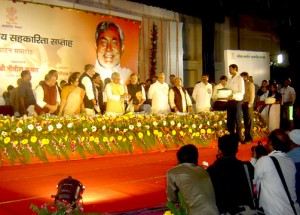 Tortillas made from quality protein maize (QPM) are now being sold on the streets in Patna, the capital city of Bihar, India. CIMMYT-India donated a QPM tortilla unit to Magadh Credit Cooperative Society (MCCS) and the society is now selling five tortillas with curry for about US$ 0.25 (10-12 rupees). The program is based on a “meals on wheels” scheme and the food will be sold at mobile shops and Sudha milk booths across Patna. The goal is to provide affordable, healthy food to the city’s urban poor. CIMMYT and Cereal System Initiative for South Asia (CSISA) are working to strengthen inbred production of hybrid QPM seed in eastern India to support this production chain.
Tortillas made from quality protein maize (QPM) are now being sold on the streets in Patna, the capital city of Bihar, India. CIMMYT-India donated a QPM tortilla unit to Magadh Credit Cooperative Society (MCCS) and the society is now selling five tortillas with curry for about US$ 0.25 (10-12 rupees). The program is based on a “meals on wheels” scheme and the food will be sold at mobile shops and Sudha milk booths across Patna. The goal is to provide affordable, healthy food to the city’s urban poor. CIMMYT and Cereal System Initiative for South Asia (CSISA) are working to strengthen inbred production of hybrid QPM seed in eastern India to support this production chain.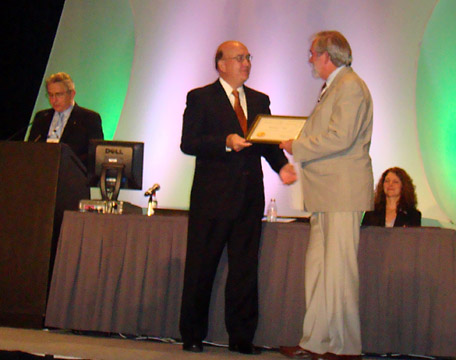 Pat Wall obtains ASA recognition
Pat Wall obtains ASA recognition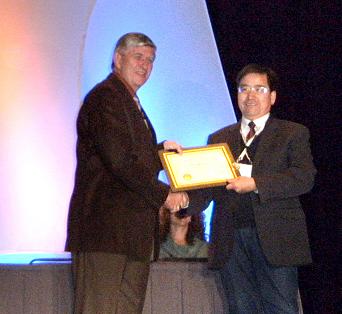 Zhonghu He, principal scientist of CIMMYT’s Global Wheat Program and country representative in China was selected for the 2009 Fellow of Crop Science Society of America (CSSA). The awarding ceremony was held on 3 November during the ASACSSA- SSSA International Annual Meeting in Pitt sburgh. Dr. He made signifi cant contributions in improving Chinese wheat quality, development and application of molecular markers, promotion of international and domestic collaboration, and training. He also received the most prestigious award from Chinese government in 2008 and CGIAR Regional Award in 2007.
Zhonghu He, principal scientist of CIMMYT’s Global Wheat Program and country representative in China was selected for the 2009 Fellow of Crop Science Society of America (CSSA). The awarding ceremony was held on 3 November during the ASACSSA- SSSA International Annual Meeting in Pitt sburgh. Dr. He made signifi cant contributions in improving Chinese wheat quality, development and application of molecular markers, promotion of international and domestic collaboration, and training. He also received the most prestigious award from Chinese government in 2008 and CGIAR Regional Award in 2007.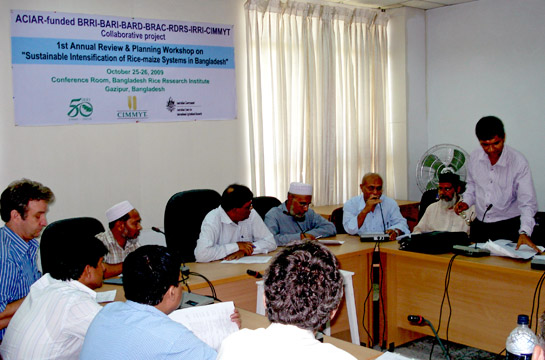 Partners of the “Sustainable intensification of rice-maize production systems in Bangladesh” met 25-29 October 2009 for the project’s first annual review—the program started in June 2008 and will run until 2013. Nearly 50 people attended the meeting held at the Bangladesh Rice Research Institute (BRRI) in Gazipur, Bangladesh. The Australian Center for International Agricultural Research (ACIAR) funds the project, which focuses on research and technology delivery for conservation agriculture (CA) and site-specific nutrient management (SSNM).
Partners of the “Sustainable intensification of rice-maize production systems in Bangladesh” met 25-29 October 2009 for the project’s first annual review—the program started in June 2008 and will run until 2013. Nearly 50 people attended the meeting held at the Bangladesh Rice Research Institute (BRRI) in Gazipur, Bangladesh. The Australian Center for International Agricultural Research (ACIAR) funds the project, which focuses on research and technology delivery for conservation agriculture (CA) and site-specific nutrient management (SSNM).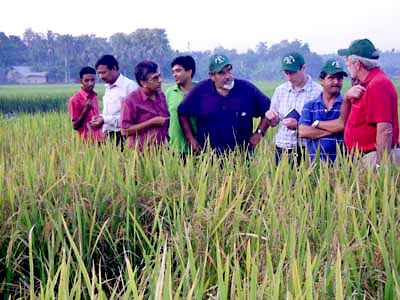 The last three days of activities took place in the research stations of BARI, BRRI, and the Bangladesh Academy for Rural Development (BARD), as well as at on-farm sites in Rajshahi and Comilla. Scientists spoke with farmers about the benefits of CA technologies and received feedback from the farmers about the different technologies tested in their fields as well as overall project activities. First year CA activities for maize primarily focused on seeding on flat land with a power tiller operated seeder (PTOS) and seeding with a bed former/planter on raised beds under reduced tillage. For rice, emphasis has been on direct-seeded rice with the PTOS, direct-seeded rice using a bed former/planter, and transplanting seedlings on raised beds.
The last three days of activities took place in the research stations of BARI, BRRI, and the Bangladesh Academy for Rural Development (BARD), as well as at on-farm sites in Rajshahi and Comilla. Scientists spoke with farmers about the benefits of CA technologies and received feedback from the farmers about the different technologies tested in their fields as well as overall project activities. First year CA activities for maize primarily focused on seeding on flat land with a power tiller operated seeder (PTOS) and seeding with a bed former/planter on raised beds under reduced tillage. For rice, emphasis has been on direct-seeded rice with the PTOS, direct-seeded rice using a bed former/planter, and transplanting seedlings on raised beds.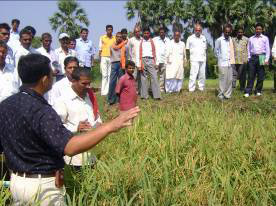 Three years of sowing experience with conservation agriculture (CA) practices in a rice-wheat system at an agricultural outreach station (KVK) in the Jamui district of Bihar State in India have been successful. So far, results show that dry, direct-seeded rice or transplanted rice on permanent beds give higher yields than other crop establishment methods, said KVK agronomist P.K. Singh to visitors during a CA farmer’s field day.
Three years of sowing experience with conservation agriculture (CA) practices in a rice-wheat system at an agricultural outreach station (KVK) in the Jamui district of Bihar State in India have been successful. So far, results show that dry, direct-seeded rice or transplanted rice on permanent beds give higher yields than other crop establishment methods, said KVK agronomist P.K. Singh to visitors during a CA farmer’s field day.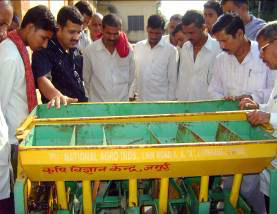 Later in the day, farmers viewed various plots sown with different CA practices, during which they asked questions and saw CA machinery demonstrations. Dry, direct-seeded rice with anchored residues in a permanent no-till system caught the attention of many participants, along with the high-yielding, unpuddled transplanted rice on permanent beds. Farmers also discussed weed management practices for various crops with Ravi Gopal, agronomist for the Cereal Systems Initiative for South Asia (CSISA). The event was part of CSISA’s delivery objective for the central Bihar Hub.
Later in the day, farmers viewed various plots sown with different CA practices, during which they asked questions and saw CA machinery demonstrations. Dry, direct-seeded rice with anchored residues in a permanent no-till system caught the attention of many participants, along with the high-yielding, unpuddled transplanted rice on permanent beds. Farmers also discussed weed management practices for various crops with Ravi Gopal, agronomist for the Cereal Systems Initiative for South Asia (CSISA). The event was part of CSISA’s delivery objective for the central Bihar Hub. CIMMYT joins with members of the international development community to mourn the passing of Nobel Peace Laureate and renowned wheat scientist, Dr. Norman E. Borlaug, who died Saturday night at the age of 95 from complications from cancer, after an exemplary life dedicated to fighting hunger in developing countries.
CIMMYT joins with members of the international development community to mourn the passing of Nobel Peace Laureate and renowned wheat scientist, Dr. Norman E. Borlaug, who died Saturday night at the age of 95 from complications from cancer, after an exemplary life dedicated to fighting hunger in developing countries.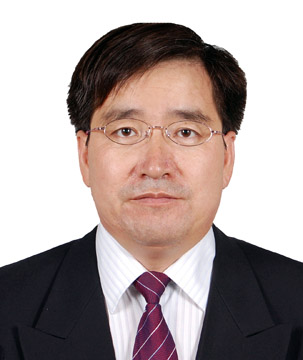 The
The  CIMMYT staff in Kazakhstan organized an international conference on conservation agriculture (CA) 08-10 July 2009 in northern Kazakhstan at the Institute for Grain Farming. The conference, “No-till with soil cover and crop rotation: A basis for policy support to conservation agriculture for sustainable production intensification,” was financed by the
CIMMYT staff in Kazakhstan organized an international conference on conservation agriculture (CA) 08-10 July 2009 in northern Kazakhstan at the Institute for Grain Farming. The conference, “No-till with soil cover and crop rotation: A basis for policy support to conservation agriculture for sustainable production intensification,” was financed by the 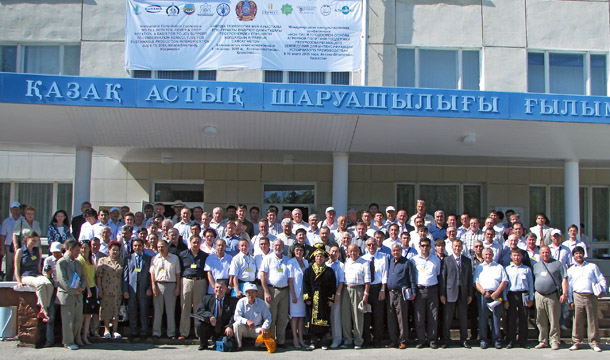 The conference highlighted the many problems still to be overcome for CA dissemination including the need for reorganization of many of the research and extension systems. Necessary diversification of cropping systems is often hampered by governmental policies and/or undeveloped markets. Weeds continue to be a problem and there is a lack of information on the adaptation of different crop varieties to CA, according to Wall.
The conference highlighted the many problems still to be overcome for CA dissemination including the need for reorganization of many of the research and extension systems. Necessary diversification of cropping systems is often hampered by governmental policies and/or undeveloped markets. Weeds continue to be a problem and there is a lack of information on the adaptation of different crop varieties to CA, according to Wall.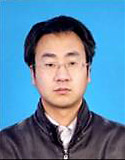 PhD student Xuecai Zhang from CIMMYT-China was recently awarded a 2009 fellowship from the International Fund for Agricultural Research (IFAR). Zhang was given USD 11,000 to work on the integration of marker-assisted recurrent selection (MARS) in conventional maize breeding at CIMMYT.
PhD student Xuecai Zhang from CIMMYT-China was recently awarded a 2009 fellowship from the International Fund for Agricultural Research (IFAR). Zhang was given USD 11,000 to work on the integration of marker-assisted recurrent selection (MARS) in conventional maize breeding at CIMMYT.